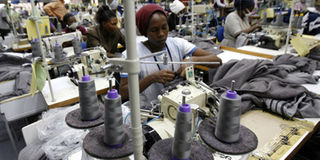Plans underway to move textile makers to Olkaria

Workers prepare clothes for export at the Alltex export processing zone (EPZ) factory in Athi River.
Plans are afoot to move textile industries in the Export Processing Zone to Olkaria to tap natural steam and hence cut the cost of energy.
The Cabinet secretary for Energy and Petroleum, Mr Davis Chirchir said last week that the shift would allow manufacturers in the apparel sector to use geothermal steam instead of diesel-run boilers to produce steam.
The move is aimed at reducing the cost of manufacturing and increasing output.
“We are seeking to relocate particularly the apparel sector and give it that low cost of power. Geothermal steam doesn’t just have to go to development of power. You can do direct use of steam,” said Mr Chirchir.
DUTY FREE
He was speaking at a function in which the leaders who accompanied President Uhuru Kenyatta to the US-Africa Summit submitted their reports of the tour.
At the moment, most of the apparel industries are located in the Export Processing Zone (EPZ) in Athi River.
Kenya exports apparel articles mainly to the United States under the African Growth and Opportunity Act (Agoa), a duty-free partnership between the two countries that has lasted for more than a decade.
The export value of apparel products under AGOA increased by 7.5 per cent to stand at Sh23.9 billion last year, according to data from the Kenya National Bureau of Statistics (KNBS).
The Kenya Electricity Generating Company (KenGen) is currently developing power from geothermal steam in Olkaria.
The government has identified geothermal resources as the main source of power in its ambitious plan to increase electricity generation capacity by 5,000 megawatts in four years staring last September.
NUMBER SEVEN GLOBALLY
This, according to the energy ministry, will enable the country to shift from relying on weather-prone hydro resources and diesel-driven thermal electricity and reduce the price of power by half.
The Ministry of Energy and Petroleum says Kenya has the potential to produce 10,000 megawatts of power from geothermal resources, although the current capacity in the national grid is yet to reach 500 megawatts.
“With about 600 megawatts of geothermal electricity by the end of this year, we will be about number seven in the whole world,” said Mr Chirchir.
Manufacturers have supported the plan to move the industries to Olkaria, saying it would lead to “a significant” reduction in the cost of energy.
“We would support such a project. Olkaria is an ideal location to set up industries and we have had such discussions before,” said Ms Betty Maina, the chief executive officer of the Kenya Association of Manufacturers.
INDUSTRIAL PARK
KenGen has in the past expressed interest in setting up an industrial park in the Olkaria area and using the available steam as a selling point to manufacturers who, in the proposal, are expected to lease space for setting up industries from the power generator.
According to a brief from KenGen, the process of setting up the industrial park would involve support from the Ministry of Industrialisation and the Export Processing Zones Authority, which is mandated to manage the special processing zones.
The Kenya National Bureau of Statistics has blamed increasing energy costs on the low performance of the manufacturing sector last year. The government has set a target of transforming the economy to middle-income status by 2030.
According to KNBS, the manufacturing sector grew by 4.8 per cent last year from 3.2 per cent in 2012, pushed by increased investor confidence, stable exchange rates, and ease in inflationary pressure during the year.
Total sales from the EPZ enterprises increased from Sh44.3 billion in 2012 to Sh49.5 billion in 2013, with exports accounting to 88.1 per cent.





